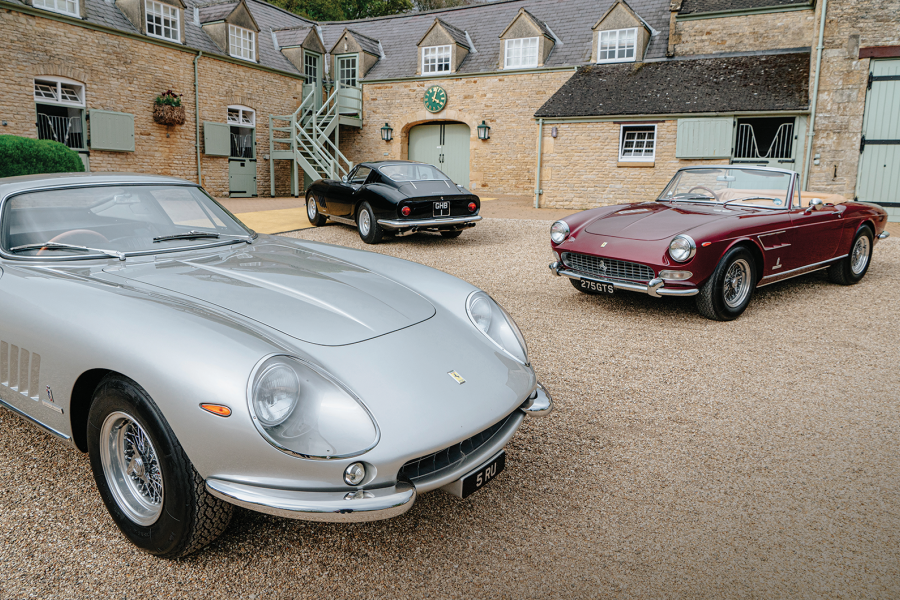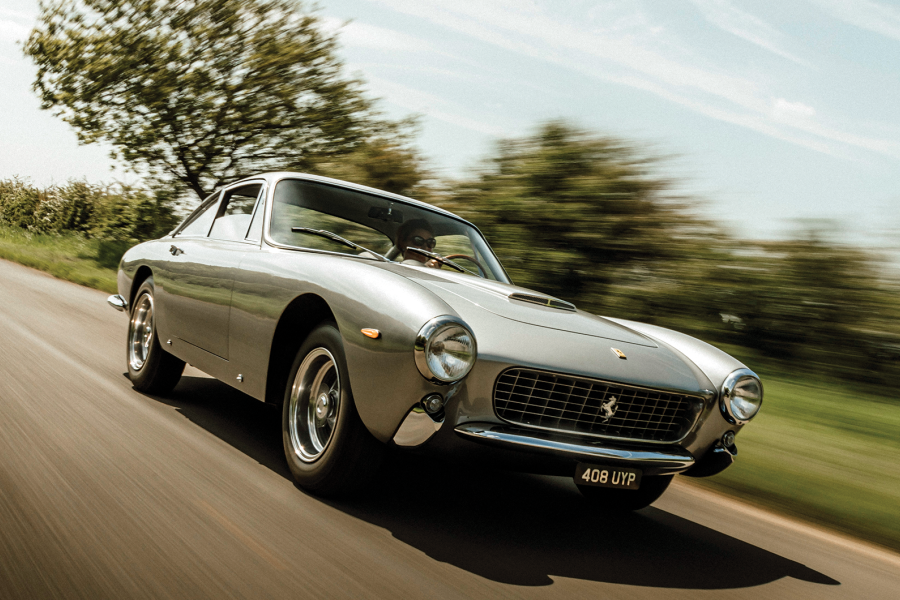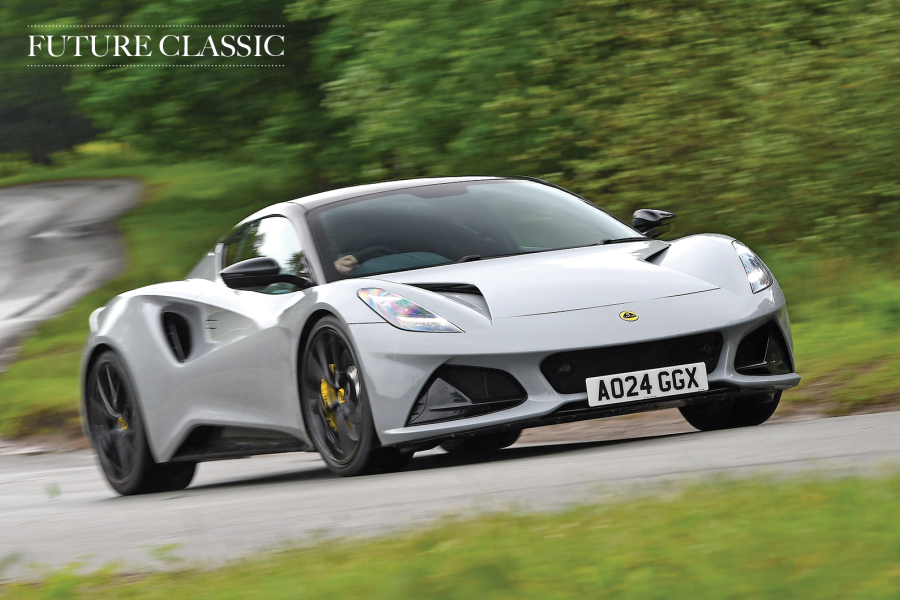The whoosh of the turbo inspires thoughts of the next age of supercars, while the twin Dell’Orto carbs offer a thrilling gargle in the background.
It generates impressive grip, and the sharp brakes and slick gearbox inspire confidence, even if it does feel a little less sure of itself at the limit compared with the 328.
Chromed toggles from the 308 were replaced by black plastic for the Ferrari 328
Next to the extroverted Italians, the Lotus has an air of elegance and quiet confidence.
The crisp, minimal detail in Peter Stevens’ neat redesign is exemplified perfectly by the floating glass ‘tunnel-back’ rear panel over the engine cover.
It’s an addition that subtly designates this as a Turbo model and hints at other, unseen aerodynamic features at work, such as the carefully profiled undertray that helps cool the engine and brakes.
The Lotus Esprit’s turbo ‘four’ uses a Renault gearbox with longer gearing
Inside, the Esprit is a big improvement over earlier cars and the impression is of a modern, resolved design – helped in no small part by the large, smoked-glass lift-out sunroof (the other two have painted removable panels).
However, those initial impressions inevitably fade to disappointment as you begin to spot clumsy stitching and mismatched air vents.
The money has been spent beneath the surface. The glassfibre panels that form the body around its steel backbone chassis used the novel new Vacuum Assisted Resin Injection process that meant Lotus could produce six bodies a day.
A large glass engine cover formed a ‘tunnel-back’ rear for this classic Lotus
Reinforced with Kevlar around the roof and sides, and glassfibre-covered polyurethane foam in the sills, its torsional rigidity was greatly increased – but so was weight, which was now marginally above the 1325kg claimed for Ferrari’s relatively old-fashioned spaceframe 328.
The Lamborghini suffers the most with its heft, however, coming in at a considerable 1407kg, and it is surprising to note that it has the relative sophistication of a semi-monocoque and a stressed steel body.
While undoubtedly the ultimate development of the Urraco, the legacy of the baby Lambo’s rush to production still left it feeling like an Airfix model with the sprues not yet filed off.
The revised X180 Lotus Esprit was roomier than its predecessor
Fortunately, it has the engine to compensate. While the Ferrari is still winding its twin overhead camshafts up towards a 5500rpm torque peak and the Lotus is summoning its 9.5psi of boost, the Jalpa explodes instantly under your right foot.
In almost any gear, it feels as though all of its 231lb ft is ready to snap the reins tight and catapult you down the road, over the hill and beyond the horizon.
Noting that the peak is at 3500rpm seems almost arbitrary amid the thunderous sound and savage scramble for speed.
The Jalpa sits more squarely than the earlier, short-lived Lamborghini Silhouette
It also has an appetite for gears, with the shortest ratios here, but switching between them isn’t as slick as it is in the other two – although it’s a marked improvement over the two-handed action required in the larger Countach.
Conversely, the Jalpa’s low-geared steering, at 4.2 turns from lock to lock, makes for response at the wheel that is more relaxed than the Ferrari’s hyper-agile turn-in and the lower-geared but more linear Lotus.
The Jalpa’s controls, including the awkwardly placed pedals, serve only as facilitators to unleash the savagery of the engine, rather than to offer much joy in themselves.
A modular dashboard disguises the Jalpa’s off-the-shelf dials
They nearly disguise the fact that the Lamborghini has tidy handling with a balance that promises to be sweet, even if you know better than to test it.
The brakes have the softest response here, but at the same size as the others they ought to have similar ultimate performance.
It rides well, too, at least at speed, and the Jalpa has the most spacious cabin of the trio, with the best seats – albeit still very much for slender Latin types.
Nascent carphone tech in this classic Lamborghini
There’s an overwhelming sense of grand-touring glamour about the Lamborghini that has you imagining taking it to the south of France. Shame, then, that the remarkably low gearing would make it fussy – and thirsty – over a long cruise.
Much of its star-sprinkled character is derived from the wild styling. It achieves all the drama you’d expect of a baby Lamborghini, but it was a new design language that birthed the Jalpa, different to Gandini’s ill-fated Countach-in-miniature Bravo concept of 1974.
Taking the lead instead from the 1980 Athon show car, an edgy spider of overlapping shapes designed by Frenchman Marc Deschamps, the square-jawed Jalpa has half-hexagonal wheelarches and flat OZ wheels, although the production drop-top was never realised.
New heads upped the Lamborghini V8’s compression ratio to 10.1:1
The car was originally designed with a subtle boot spoiler, but a Countach-style wing was a last-minute addition, while the more classically styled teledial wheels from the Silhouette became an option in 1984.
Bertone’s ‘styling exercise’ was in truth a slightly desperate attempt by Lamborghini’s new owners to drum up business. It would also be the last car from Sant’Agata styled by Nuccio’s design house.
Blending Lamborghini’s trademark exhilarating brutality and sci-fi looks with a surprising amount of passenger comfort and luggage space, the Jalpa feels like a creative success – if not a commercial one.
‘The junior supercars of the 1980s set a new standard for a class that had hitherto been an exclusive arena for punishing cars supplying only hard-earned rewards’
Lotus already had design success, but with the more refined, practical and production-efficient X180 it secured another 16 years for the Esprit and was a landmark for Norfolk continuing to add lightness without so much compromise.
All three are exciting, rewarding cars to drive, but the 328 is an especially finely tuned sensation. Its spine-tingling sounds, tactile responses and delicate lines elevate it into the rarefied land in which Ferrari seems to occupy so many acres.
Refined into such a compact package, more often and more broadly accessible, it is an exceptionally powerful dispelling of any reductive notions that might come with the word ‘junior’.
Images: Max Edleston
Thanks to: Mark Osborne; Mark Bogard; Verdi Ferrari
Factfiles
Ferrari 328GTS
- Sold/number built 1985-’89/7412
- Construction steel spaceframe chassis, steel body
- Engine all-alloy, dohc-per-bank, 32-valve 3185cc V8, Bosch K-Jetronic fuel injection
- Max power 266bhp @ 7000rpm
- Max torque 224lb ft @ 5500rpm
- Transmission five-speed manual, RWD
- Suspension independent, by double wishbones, coil springs, telescopic dampers, anti-roll bar f/r
- Steering rack and pinion
- Brakes discs, with servo and ABS
- Length 13ft 11½in (4255mm)
- Width 5ft 8⅛in (1730mm)
- Height 3ft 8½in (1128mm)
- Wheelbase 7ft 8in (2350mm)
- Weight 2921lb (1325kg)
- 0-60mph 5.5 secs
- Top speed 153mph
- Mpg 18
- Price new £42,732 (1988)
- Price now £60-100,000+*
Lotus Esprit Turbo
- Sold/number built 1988-’93/2281
- Construction steel backbone chassis, glassfibre body
- Engine all-alloy, dohc, 16-valve 2174cc ‘four’, twin Dell’Orto carburettors, Garrett T3 turbocharger
- Max power 215bhp @ 6000rpm
- Max torque 220lb ft @ 4250rpm
- Transmission five-speed manual, RWD
- Suspension independent, at front by double wishbones rear transverse links, radius arms; coil springs, telescopic dampers, anti-roll bar f/r
- Steering rack and pinion
- Brakes discs, with servo
- Length 14ft 2½in (4331mm)
- Width 6ft 1¼in (1859mm)
- Height 3ft 9¼in (1151mm)
- Wheelbase 8ft ¾in (2458mm)
- Weight 3052lb (1386kg)
- 0-60mph 5.4 secs
- Top speed 150mph
- Mpg 20
- Price new £29,950 (1988)
- Price now £20-40,000*
Lamborghini Jalpa
- Sold/number built 1981-’88/410
- Construction steel monocoque
- Engine all-alloy, ohc-per-bank, 16-valve 3485cc V8, four twin-choke downdraught Weber carburettors
- Max power 255bhp @ 7000rpm
- Max torque 231lb ft @ 3500rpm
- Transmission five-speed manual, RWD
- Suspension independent, by MacPherson struts, anti-roll bar f/r
- Steering rack and pinion
- Brakes discs, with servo
- Length 14ft 2½in (4330mm)
- Width 6ft 2in (1880mm)
- Height 3ft 8⅞in (1140mm)
- Wheelbase 8ft 8½in (2450mm)
- Weight 3109lb (1407kg)
- 0-60mph 6.2 secs
- Top speed 144mph
- Mpg 16
- Price new £43,656 (1988)
- Price now £80-100,000*
*Prices correct at date of original publication
Enjoy more of the world’s best classic car content every month when you subscribe to C&SC – get our latest deals here
READ MORE
Ferrari 250GTE: Enzo’s roadgoing winner
The specialist: Lamborghini Polo Storico
Brave new world: TVR Cerbera vs Lotus Esprit
Aaron McKay
Aaron is Classic & Sports Car’s Deputy Editor





























